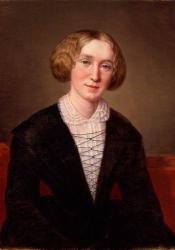George Eliot Publishes Adam Bede Under Pseudonym in 1859
Mary Ann Evans, born in Warwickshire in 1819, adopted the pseudonym George Eliot for publication of her work, including her first novel, Adame Bede in 1859. During the early to mid-Victorian era, the parameters of the feminine literary tradition were narrow and restrictive, literature by women often being dismissed as sentimental, frivolous, and domestic. To establish themselves “without assuming feminine identities” (Cambridge) and the accompanying stereotypes, many female writers of the time published under pseudonyms. By doing so, they were able to widen their scope beyond the traditional “domain of feminine writing” (Cambridge) into areas such as politics, social issues, gender roles, economics, and other conventionally masculine topics. Through her journalistic persona, George Eliot experimented with narratives and negotiated relationships with her editor and audience.
One example of such critical negotiation takes place in Adam Bede, in which Eliot challenges the Victorian confines of the female by utilizing the “fallen woman” archetype. Victorian moral conventions asserted that, per Darwinian theory, women are born “angels” and men “animals.” It was considered natural for men to explore and appease their sexual appetites, but “unnatural” for women to do the same. Typical belief of Victorian culture held that a woman’s sexuality was dangerous to herself and to society. Rosalind White explains further how a Victorian woman’s identity was linked to her sexuality:
“During the Victorian period a woman's identity was indisputably intertwined with her sexual status; a woman was either an untainted "maiden," a wife or mother (which placed her sexuality safely in the domestic sphere), or she was vilified by labels such as "spinster" or "whore," both of which had negative connotations, the former with sexual atrophy, the latter with deviant promiscuity. Essentially, any deviance from the paragon of ideal Victorian womanhood, the "angel of the house," insinuated that a woman's fall was imminent.”
Eliot challenged this Victorian ideal by using the “fallen woman”, a term which “refers to an irrevocable loss of innocence, a concept originating in the biblical fall in the Garden of Eden; the characterisation of Eve as temptress inextricably links her fallen state with the loss of sexual purity” (White). Hetty Sorrel, one of the main characters in Adam Bede is a perfect portrait of the Victorian "fallen woman". A lower-class maiden, Hetty is seduced by a life of jewels and satin and becomes sexually corrupted by a man who is above her station and has no intention of marrying her.
Had George Eliot not adopted that pseudonym, her infamous work, her psychological realism, and her striking honesty about provincial life in rural England may not have been received and/or accepted in the way that it was.
SOURCES:
http://www.victorianweb.org/gender/fallen2.html
https://artuk.org/discover/stories/ten-women-who-used-pseudonyms-and-one-man#

